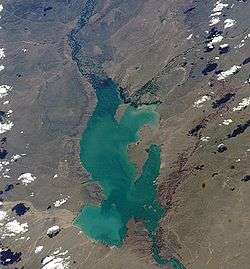Limay River
| Limay River | |
|---|---|
 A aerial view of the Limay River | |
| Country | Argentina |
| Physical characteristics | |
| Main source |
Nahuel Huapi Lake 770 m (2,530 ft) AMSL |
| River mouth |
into Río Negro 38°59′35″S 68°00′18″W / 38.993°S 68.005°WCoordinates: 38°59′35″S 68°00′18″W / 38.993°S 68.005°W |
| Length | 380 km (240 mi) |
| Discharge |
|
| Basin features | |
| Basin size | 61,723 km2 (23,831 sq mi) |

The Limay River is an important river in the northwestern Argentine Patagonia (the region of Comahue). It is born at the eastern end of the Nahuel Huapi Lake and flows in a meandering path for about 380 kilometres (240 mi), collecting the waters of several tributaries, such as the Traful River, the Pichileufú and the Collón Curá. It then meets the Neuquén River and together they become the Río Negro. At this confluence lies the city of Neuquén.
The river serves as natural limit between the provinces of Río Negro and Neuquén. Its deep waters are clear, and carry a large flow, 700 cubic metres per second (25,000 cu ft/s) on average. Its drainage basin has an area of 61,723 square kilometres (23,831 sq mi) and includes almost all the rivers and streams of the Atlantic basin in the region, as well as an extensive network of lakes.
The waters of the Limay are used to generate hydroelectricity at the five dams built on its course: Alicurá, Piedra del Águila, Pichi Picún Leufú, El Chocón, and Arroyito; together with the Cerros Colorados Complex on the Neuquén River they contribute with more than one quarter of the total hydroelectric generation in the country. The construction of the successive dams and reservoirs has reduced the length of the river, originally about 450 kilometres (280 mi). Next to it, at the town of Arroyito, was constructed in the 1980s the only heavy water plant in South America.
The river is also used for fly fishing, and in some points its banks are suitable as beach resorts, with facilities for camping.This river has been covered with volcanic ash lately (2011) as the volcano, Puyehue has been erupting since June 2011.
References
- Colbert E. Cushing, Kenneth W. Cummins, G. Wayne Minshall: River and Stream Ecosystems of the World: With a New Introduction. University of California Press 2006, ISBN 0-520-24567-9, S. 280ff (eingeschränkte Online-Version (Google Books))
- Argentour — Río Limay
- Pescando con Mosca en la Patagonia Argentina
- Ministry of Environment — Hydrological basins of Argentina.
- Ministry of Economy — Provincial Economic Overview, Neuquén, August 2005.